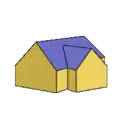Gable roof
A gable roof[1] is the classic, most commonly occurring roof shape in those parts of the world with cold or temperate climates. It consists of two roof sections sloping in opposite directions and placed such that the highest, horizontal edges meet to form the roof ridge. The design of this type of roof is achieved using rafters, roof trusses or purlins. The pitch of the roof and the height of the gutters can vary greatly.


Distribution
The gable roof is so common because of the simple design of the roof timbers and the rectangular shape of the roof sections. This avoids details which require a great deal of work or cost and which are prone to damage. If the pitch or the rafter lengths of the two roof sections are different, it is described as an 'asymmetrical gable roof'. A gable roof on a church tower (gable tower) is usually called a 'cheese wedge roof' (Käsbissendach) in Switzerland.
Its versatility means that the gable roof is used in many regions of the world. In regions with strong winds and heavy rain, gable roofs are built with a steep pitch in order to prevent the ingress of water. By comparison, in alpine regions, gable roofs have a shallower pitch which supports snow better, reducing the risk of an uncontrolled avalanche and more easily retaining an insulating layer of snow.
Gable roofs are most common in cold climates. They are the traditional roof style of New England and the east coast of Canada. Fans of literature in both countries will recognize the roof style from popular novels. Nathaniel Hawthorne’s “The House of Seven Gables” and Lucy Maud Montgomery’s “Anne of Green Gables” both reference this roof style in their titles.[2]
Advantages and disadvantages
Gable roofs have several advantages:[3]
- They are inexpensive
- They may be designed in many different ways.
- They are based on a simple design principle.[4]
- They are more weather-resistant than flat roofs
But gable roofs also have some disadvantages:
- Only roof windows and gable windows may be used for illumination.
- Low-pitch gable roofs result in a loss of living space. This may be partly compensated for e.g. by the installation of dormers.
- Gable roofs are more prone to wind damage than hip roofs.[5]
Types and categorisation
Gable roofs may be constructed with different pitches and these are sometimes categorised by different names. For example in German-speaking countries the types of gable roof are:
- Shallow gable roof (flaches Satteldach) with a pitch of ≤ 30°
- New German (neudeutsches Dach) or angled roof (Winkeldach) with a pitch of 45°
- When the pitch it greater than 62° it is called a Gothic (gotisches) or Old German roof (altdeutsches Dach)
- If the roof has the shape of an equilateral triangle and 60° pitch it is called an Old Franconian (altfränkisches) (commonly found in the region of Franconia) or Old French roof (altfranzösisches Dach)[6]
See also
References
- Fritz Baumgart: DuMont’s kleines Sachlexikon der Architektur. Cologne, 1977.
- "Hip Roof vs. Gable Roof". IKO website. IKO Industries Ltd. Retrieved January 21, 2021.
- Informationen rund ums Satteldach. Retrieved 20 June 2012.
- "Satteldach: Die einfache Konstruktion hat sich bewährt. Retrieved 20 June 2012". Archived from the original on 30 January 2014. Retrieved 14 January 2017.
- Grazulis, Thomas P. (1993). Significant tornadoes, 1680-1991: A Chronology and Analysis of Events. St. Johnsbury, Vermont: Environmental Films. p. 106. ISBN 1-879362-03-1.
- Willibald Mannes, Franz-Josef Lips-Ambs: Dachkonstruktionen in Holz, Deutsche Verlags-Anstalt, 1981, ISBN 3-421-03283-1.
External links
| Wikimedia Commons has media related to Gable roofs. |
| Look up gable roof in Wiktionary, the free dictionary. |
